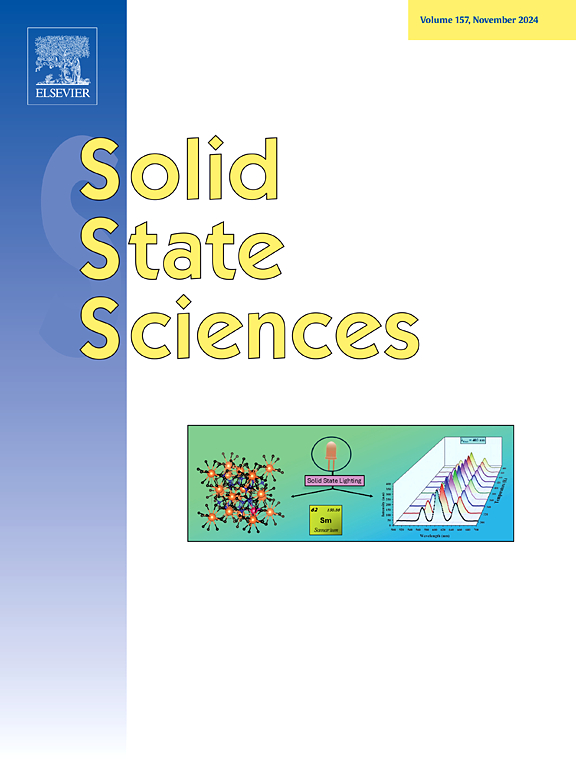A detailed investigation into the curing kinetics of zinc borate-epoxy composites
IF 3.3
3区 化学
Q2 CHEMISTRY, INORGANIC & NUCLEAR
引用次数: 0
Abstract
Epoxy resins (E) are widely used in composite applications due to their superior properties such as lightweight, manufacturing flexibility, and compatibility with numerous reinforcement elements. To enhance these properties and mitigate drawbacks like low toughness, curing agents that improve chain linkages and nanofillers are employed. Nano-sized zinc borates (ZB), commercially available materials, are frequently studied for improving the thermal stability, mechanical strength, and fire resistance of polymeric structures. ZB, with the formula 2ZnO·3B2O3·3.5H2O, is a white crystalline nanomaterial that possesses low toxicity, anti-corrosive properties, low density, and compatibility with various polymers. Although many studies focus on improving the thermal stability and mechanical properties of ZB-epoxy composites (ZB-E), research on curing processes remains limited. However, selecting parameters like temperature and curing duration under system transformations is crucial for composite production. Curing kinetic parameters are essential for accurately analyzing these processes. This study evaluates the curing process of epoxy systems containing different mass fractions of ZB (2-4-6-8-10 %) through dynamic differential scanning calorimetry (DSC) tests. DSC analyses were conducted at various heating rates (3-6-9 °C/min) with a final curing temperature of 120 °C. The obtained data were analyzed using different phenomenological kinetic equation models (Kissinger, Flynn-Wall-Ozawa, Boswell, and Moynihan) in Matlab-R2019b, and the curing kinetic parameters were calculated. At the same time, the reaction order was calculated using the Crane method. In the final stage, Arrhenius equations were applied to determine the activation energies of the systems. This study assesses the influence of ZB addition on epoxy curing kinetics and the activation energies of ZB-E structures. The activation energy (Ea) values calculated from different models (Kissinger, FWO, Moynihan, and Boswell) show some variation, but the overall trend is consistent: as the ZB content increases, the activation energy generally decreases. The Ea value calculated using the Kissinger, FWO, Moynihan, and Boswell methods decreases by approximately 35.48 %, 33.27 %, 33.27 %, and 34.63 % respectively, when the ZB content increases from 0 % to 10 %. It also provides a new perspective for pre-production optimization and characterization of composite curing systems, aiming to reduce manufacturing costs and production times.

硼酸锌-环氧复合材料固化动力学的详细研究
环氧树脂(E)由于其优异的性能,如轻质、制造灵活性和与许多增强元件的兼容性,在复合材料应用中得到广泛应用。为了提高这些性能并减轻低韧性等缺点,采用了改善链连接的固化剂和纳米填料。纳米级硼酸锌(ZB)是一种商用材料,经常被研究用于提高聚合物结构的热稳定性、机械强度和耐火性。ZB的分子式为2ZnO·3B2O3·3.5H2O,是一种白色结晶型纳米材料,具有低毒、耐腐蚀、低密度和与多种聚合物的相容性。虽然许多研究都集中在提高zb -环氧复合材料(ZB-E)的热稳定性和力学性能上,但对固化工艺的研究仍然有限。然而,在系统转变下,选择温度和固化时间等参数对复合材料的生产至关重要。固化动力学参数是准确分析这些过程的关键。通过动态差示扫描量热法(DSC)测试,评价了不同ZB质量分数(2-4-6-8- 10%)的环氧树脂体系的固化过程。DSC分析在不同的加热速率下进行(3-6-9°C/min),最终固化温度为120°C。采用Matlab-R2019b中不同的现象动力学方程模型(Kissinger、Flynn-Wall-Ozawa、Boswell和Moynihan)对所得数据进行分析,并计算固化动力学参数。同时,用Crane法计算了反应级数。在最后阶段,应用Arrhenius方程确定系统的活化能。研究了ZB的加入对环氧树脂固化动力学和ZB- e结构活化能的影响。不同模型(Kissinger、two、Moynihan和Boswell)计算的活化能(Ea)值存在一定差异,但总体趋势一致,即随着ZB含量的增加,活化能总体呈下降趋势。当ZB含量从0%增加到10%时,Kissinger法、two法、Moynihan法和Boswell法计算的Ea值分别下降了35.48%、33.27%、33.27%和34.63%。它还为复合材料固化体系的生产前优化和表征提供了新的视角,旨在降低制造成本和生产时间。
本文章由计算机程序翻译,如有差异,请以英文原文为准。
求助全文
约1分钟内获得全文
求助全文
来源期刊

Solid State Sciences
化学-无机化学与核化学
CiteScore
6.60
自引率
2.90%
发文量
214
审稿时长
27 days
期刊介绍:
Solid State Sciences is the journal for researchers from the broad solid state chemistry and physics community. It publishes key articles on all aspects of solid state synthesis, structure-property relationships, theory and functionalities, in relation with experiments.
Key topics for stand-alone papers and special issues:
-Novel ways of synthesis, inorganic functional materials, including porous and glassy materials, hybrid organic-inorganic compounds and nanomaterials
-Physical properties, emphasizing but not limited to the electrical, magnetical and optical features
-Materials related to information technology and energy and environmental sciences.
The journal publishes feature articles from experts in the field upon invitation.
Solid State Sciences - your gateway to energy-related materials.
 求助内容:
求助内容: 应助结果提醒方式:
应助结果提醒方式:


